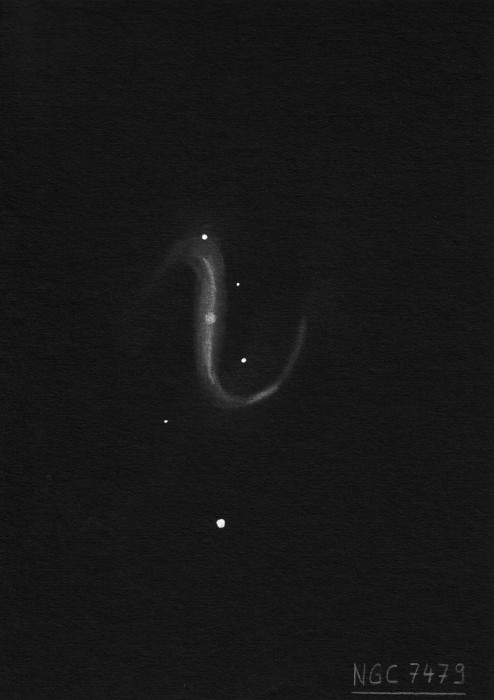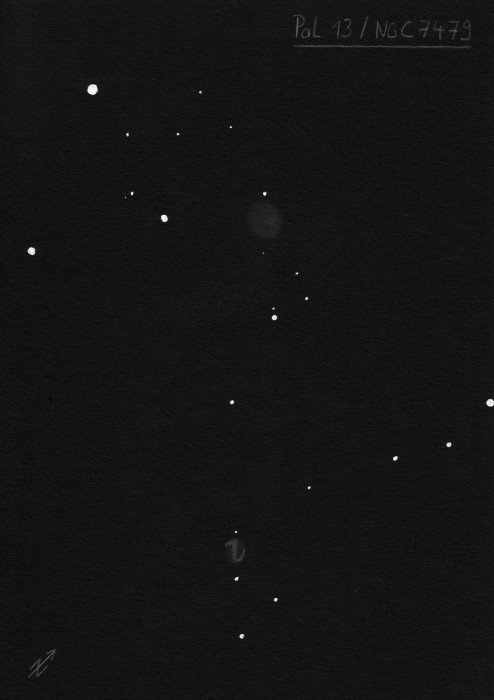Object of the Week September 21, 2014 The Propeller Galaxy NGC 7479
NGC 7479 UGC 12343 PGC 70419 MCG +02-58-60 The Propeller Galaxy
nearly face on barred spiral galaxy (SBbc)
RA: 23h 04m 56.7s Dec: +12° 19′ 22″
Size: 3.7’ x 2.8’
Mag: 10.8v
Mag: 11.7B
In his OOTW contribution last month, Paul Alsing described The Propeller Nebula, Simeis 57. So this month I couldn’t resist sharing its galaxy namesake The Propeller Galaxy, NGC 7479.
William Herschel discovered NGC 7479 in 1784 with an 18.7-inch f/13 speculum telescope. It was originally cataloged as H I-55. In his discovery notes Herschel called it “considerably bright, much elongated in the direction of the meridian, gradually brighter in the middle, 4’ long, 2’ broad.”
n7479ngcic.jpgn7479blk.jpg
Admiral William Henry Smyth in The Bedford Catalog, From A Cycle of Celestial Objects (1844) had the following to say after observing the galaxy in a 5.9-inch refractor, “This is very faint but after long gazing under clockwork motion, it comes up, trending nearly north and south, have a telescope star at each extreme. Now, the sphere being the general figure assumed in consequence of the particles mutually attracting each other, we can only suppose that the lenticular appearance before us, is a vast ring [of stars] lying obliquely to our line of vision.” What an incredible supposition given the state of astronomical knowledge and telescopes in the mid 19th century.
ngc7479hst.jpg
NGC 7479 belongs to the Pegasus Cloud, which contains 51 galaxies. It is a visually and photographically striking galaxy. It is located about 3° south of Alpha (α) Pegasi, or Markab, the southwestern corner of the Great Square. Moderately bright at a visual magnitude of 10.8, you should be able to detect the galaxy in scopes as small as 4 inches under reasonable dark skies. In fact The Propeller is an excellent example of what larger aperture and darker skies can do – showing a progressive increase in detail. In smaller telescopes NGC 7479 appears as a very faint elongated fuzzy patch. With a moderate increase in aperture the galaxy’s bar begins to materialize; likewise a tiny core becomes apparent. As the aperture increases so does the amount of detail in the arms and the core. The spiral is highly asymmetrical with the dominant feature being its inverted S, which spins in an anticlockwise direction. The westward curving spiral arm is sharply defined, while the other arm is less define, appearing like a frayed rope. Be sure to explore the spiral arms and the core at high powers. The latter has been reported to show structure under exceptional seeing.
ngc7479-lum.jpgNGC7479HW.jpgNGC_7479_copy_385x344.jpg
The beauty of NGC 7479 extends beyond the visual. At radio wavelengths the arms spin the other way, in a clockwise direction. Studies demonstrate that this radio jet was put into its bizarre backwards spin following a merger with another galaxy. In the course of my research on The Propeller Galaxy one paper I found fascinating was A minor-merger model for NGC 7479 by S. Laine and C.H Heller, which describes a numerical simulation model for the overall morphology of the galaxy that is based on a minor galactic merger.
Star formation is reignited by galactic collisions and NGC 7479 is undergoing starburst activity. It is recognized as a Seyfert II galaxy with an active galactic nucleus. In a 1999 Astrophysical Journal Supplement Series paper Rosa Gonzales Delgado (Space Telescope Science Institute) reported the discovery of 86 H II regions in the galaxy’s two main spiral arms. Supernovae 1990U and SN20009jf occurred in NGC 7479. The former was a Type Ic supernova, a massive star that self-destructed after ejecting its outer envelope of hydrogen and helium.
You'll find sketches of NGC 7479 by Deep Sky Forum members here.
Hope you enjoy The Propeller Galaxy.
“GIVE IT A GO AND LET US KNOW”
GOOD LUCK AND GREAT VIEWING!




 Reply With Quote
Reply With Quote






